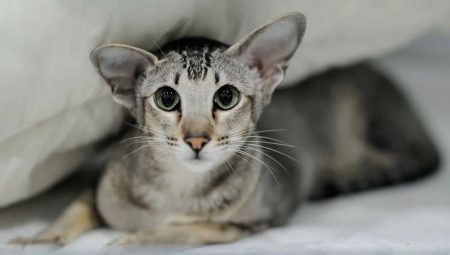Oriental cats are a breed that was officially recognized in 1977 in the United States. Seeing once the face of an animal, it is difficult not to fall in love with huge eyes, large ears and a wide nose. The breed has a muscular slender body, a thin long tail. Cats of this breed are very curious and strongly attached to their owners.
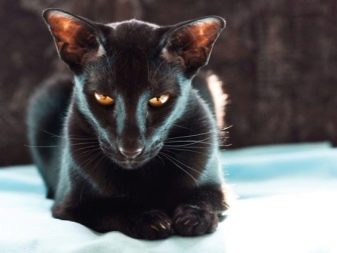
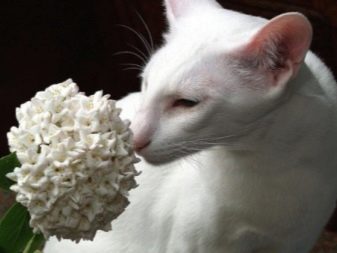
Origin history
It all started at the end of the XIX century, when the ancestors of the orientals were taken from Thailand to England along with cats of the Siamese breed. The first mention of painted Siamese dates back to 1903. Fans of this type of cats tried to decide the show fate of a new breed for the European continent. Disputes in the ranks of felinologists lasted until 1923. Everything stopped after the decision of the Siamese cats club in Britain, where it was reported that the organization does not support breeding of other breeds. In this way, one-color cats were excluded from the Siamese class, work on a new species stopped.
In the mid-50s of the 20th century, the cat Havana Brown Roofspringer Mahogany Quinn was brought to the American Kennel Quinn from England, which began the American history of orientals. Two years later, Havana Brown accepts the standard and receives the CFA title.

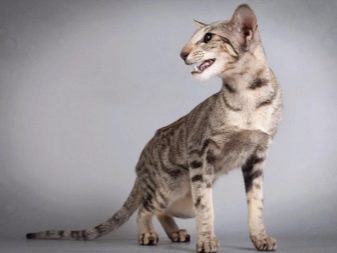
The "chocolate" cat is registered as a separate breed of Havana Brown, while the breeders manage to completely preserve its uniqueness. The original color is an important pedigree trait. In the European part of the world, this color is lost due to mixing with the Siamese.
American felinologists went further.After the company recognizing other colors in 1977, orientals finally take their place in the list of approved international cat breeds. In 1995, a breakthrough came for bi-colors - cats with a two-tone color. The longhair gene is introduced into the breed. Two years later, this kind of oriental receives the title of champion in CFA. The animal has a slender, flexible body, looks exquisitely externally, while it has developed muscles.
They may look angular, especially kittens. But cats and cats of a long-haired type have softer outlines.
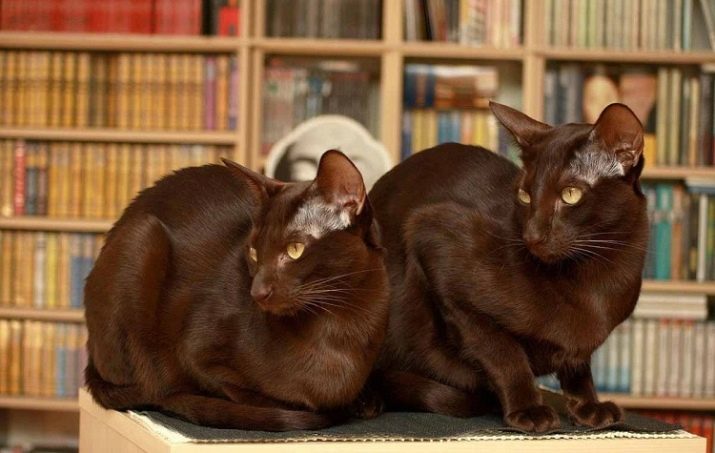
Description
By standards, oriental cats are similar to Siamese, but differ in color and type. They have the same characteristics, a description of the structure of the body and character. The animals have an unusual head shape with large ears, the body is medium in size.
The weight of the female reaches 3 kg, the males are slightly heavier - up to 5 kg. In height at the withers, growth is 25 cm, along the length of the body - no more than 90 cm. Orientals have a large number of colors.
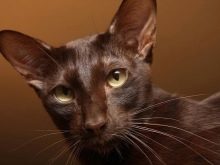
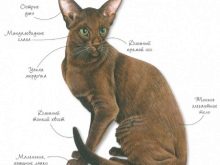
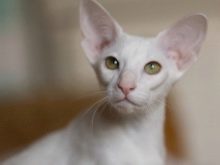
For orientals, there are the following generally accepted standards:
- head the animal has the form of a narrowing wedge;
- eyes usually almond-shaped, the color is most often green, but blue is allowed in white orientals; if the eyes are of different colors, then such animals do not participate in exhibitions or breeding; by American standards, they should be oval and evenly spaced in relation to the nose, eyes should not be convex; newborn kittens are born blind, but at orientals they open their eyes earlier than other breeds - by 8–9 days; the eyes of the kittens are gray-blue in color, after 2-3 months they turn green;
- ears immediately attract attention: wide at the base and pointed at the tips, they look as if the animal is in a wary state; eared snouts attract attention; kittens look especially interesting; orientals have the so-called early ear growth in the first 3 months of life, then the body and head catch up with them in proportion;
- body combines graceful bones and developed muscles, the abdomen is characterized by fitness;
- neck corresponds to the structure of the cat as a whole - it looks the same for males and females - slim and long;
- hind legs longer than the front;
- wool shines in an animal, silky to the touch; the pile fits tightly to the cat's body.
The disadvantages of cats include strabismus, hollows between the eyes, snub nose. If between the forehead and nose there is a so-called fracture of a straight line, then this also applies to shortcomings - according to the rules, only a straight line is allowed.
If a cat has a massive jaw, then it is also rejected from participating in the exhibition.


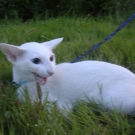

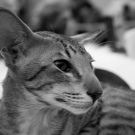

Character and habits
Many owners note the talkativeness of their favorites. They have a habit of constantly casting their voices, various signs, and they also try not to lose sight of people. Where the owner goes, the cat immediately moves there. Animals have a playful character, they enjoy cat games in the form of chasing a ball or hunting for a rustling piece of paper. They can play catch-up and hide and seek with the owner. Not only kittens love this, but also older adults.
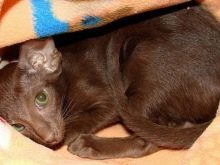
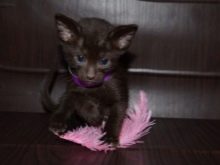
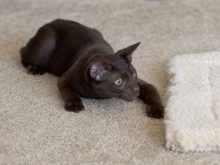
If an oriental cat appears in the house, do not wait for it to doze, curled up in a secluded place. The animal, of course, may lie in between activities, but its place to rest will be the master's desk, computer, music center, pillow, bed, back of the sofa.
In a word, a person must necessarily remain in the zone of visibility of the oriental.
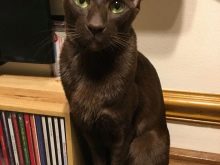
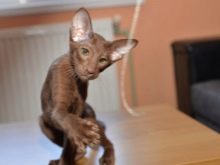
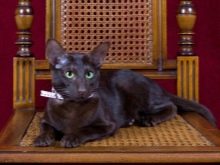
Cats can spoil things in the apartment because of their exuberant energy, therefore it is necessary to provide the pet with toys and other entertainment in the form of a house with zones for climbing and jumping.
Orientals are very curious. They participate in all the events that can occur in the house.They like to get to know the guests, they will surely follow what a person is doing in the kitchen, and will also ask for a room if the door suddenly closes in front of their nose. Cats of this breed are wonderful for children and get along well with them. You can not worry that the oriental will scratch the child. They will never allow to release their claws, even if they are experiencing not the most pleasant minutes of playing with the tail.
Orientals are good friends with other pets. The only thing they can carry them into their active games. If the cat does not have enough housekeeping attention, she will take revenge: she will hang on the curtains, sharpen her claws on furniture and ignore the person.
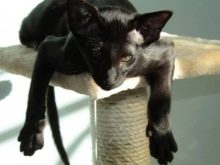

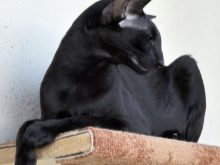
Advantages and disadvantages of the breed
Any breed has its pros and cons. Orientals are no exception. The breed has an equal number of advantages along with disadvantages. This cat is not suitable for everyone, so you need to know and be prepared for the manifestations of its stubborn nature and temperament. Owners note several drawbacks in orientals.
- They are very wayward and used to get their way.. If the pet wants to play, and the owner decides to rest at this moment, he will have to give way to the animal. They like to be in the spotlight. By virtue of their curiosity, they can climb into hard-to-reach places, like to conquer new peaks - therefore, they can jump over cabinets and curtains. If you start to train them, then all attempts will be unsuccessful. They cannot be punished, much less beaten. You just need to take the nature of the animal for granted.
- It must be understood that oriental cats are troubled “cushion” pillows, like Persians or chinchillas. Even having thoroughly reinforced, the oriental will not warm its sides under the sun on the windowsill. The animal loves outdoor activities.
- The claws of this breed grow very quickly. They need to be trimmed, so kittens need to be accustomed to the scratching post from the very first days of appearance in the house. If this is not done, then the animal will grind its claws on furniture, wallpaper or curtains.
- Orientals like to eat well and are not picky about food at all. However, the breed must be given a portion in limited quantities in order to maintain the harmony of the body of the animal. The calculation is carried out according to the following scheme: 30 grams of food per 1 kilogram of pet weight. You need to feed the animal 2 times a day. Cats are very smart and will plaintively or, conversely, brazenly beg for an additional portion.
- Another disadvantage is the high price of purebred kittens. Although thanks to this, people make a purchase of a future pet consciously.
- Orientals are susceptible to diseases that are transmitted along with genes. One of them is gingivitis, therefore it is necessary to constantly monitor the condition of the animal's oral cavity. There is retinal atrophy and blindness.
Animals are prone to upper respiratory tract infections. There are risks of diseases of the cardiovascular system and liver.
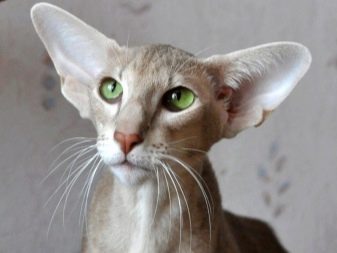
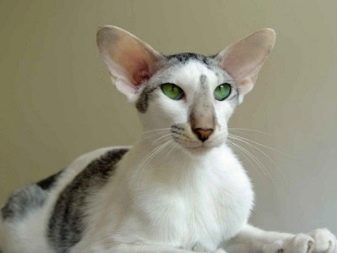
Now it is worth considering the advantages of the breed.
- Orientals are great companions. They constantly "talk" with their owners, demonstrating emotions. They are very faithful, poorly tolerate loneliness and betrayal.
- These cats feel the owner’s mood and try to adjust their behavior to it. They carefully monitor the actions of the owner and try to be near.
- They have amazing looks. Seeing them once, it’s hard to forget them later. Cats have almost no undercoat, and the coat itself is very short.
- The cat behaves well on a leash. It is best if the animal is in a harness. It will not try to escape, but it is still not necessary to release the oriental one.
- He enthusiastically plays with everythingthat rustles and rolls, using for this a variety of objects. Funny pet games will not leave anyone indifferent.
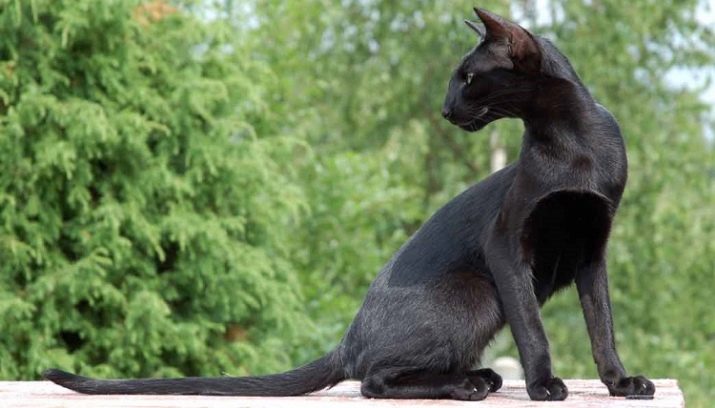
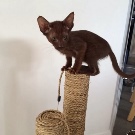
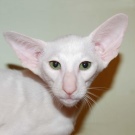
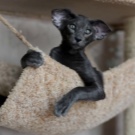
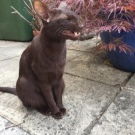
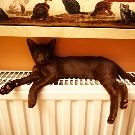
How many years live?
Life expectancy with good care can reach 18–20 years, on average, from 13 to 15 years. It all depends on heredity and compliance with the rules of crossbreeding.Orientals are considered centenarians among other cat breeds. If you translate the age limit of oriental cats on the analogue of human, then they live to an advanced 92 years.
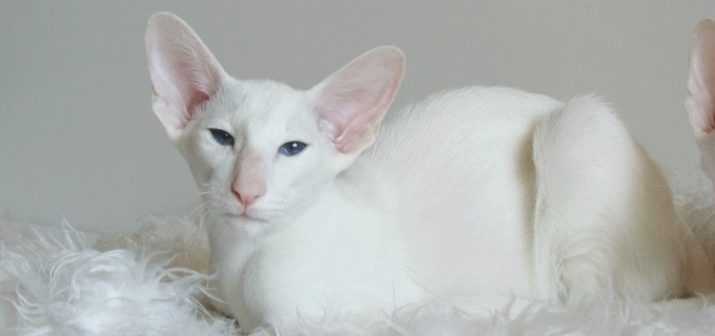
Kinds
Oriental or oriental cats can be of any color. This can be a coat color or pattern. Based on this, animals can look different. In this case, cats also differ in the length of their hair: there are short-haired and long-haired species. The latter appeared as a result of crossing Oriental cats with short hair and balines. In another way, this type of cat is called tangerines. The body of the animals looks like that of the Balinese, and the color is like that of the orientals, but the coat is semi-long.
This species is rare, although it has been recognized by international felinological organizations. The body of such cats looks stronger, compared with the shorthair appearance. Otherwise, it is not much different from the accepted standards of orientals. At the same time, the animal’s coat adheres tightly to the body and visually appears shorter, in fact, it is long and silky to the touch, has an undercoat. It is necessary to perform combing twice a week, during the molting period - preferably every day. In this form, the most valuable in color are chocolate and purple shades.
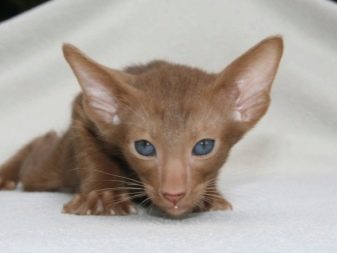
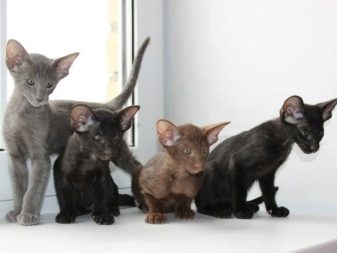
Important! Extreme species include cats with the most pronounced features of the breed. The larger the ears, the longer the muzzle, the graceful silhouette of the animal, the higher its price. In general, the requirements of the standard should be the same.
Oriental cats have about 300 species of color, but there are the following so-called basic shades:
- ebonite - refers to animals with black hair; representatives of this species have green eyes and resemble a panther;
- Havana - in this species, the nose and coat should have a uniform brown color, the pillows on the legs, respectively, are pink-brown;
- lavender or purple - gray coat, there may be a so-called hoarfrost coating, which should not be cast in blue shades;
- blue - evenly colored wool from the nose to the tip of the tail;
- cinnamon - the coat is light brown, while the nose of the animal and the pads on the legs are pink;
- faun - the following shades belong to this color: wool of beige and light gray colors in combination with a pink nose and pads on the legs;
- redhead - wool with a uniform red tint, nose and pads are pale pink;
- cream - wool is similar in color to pastel shades; the tip of the nose and pads are pink.
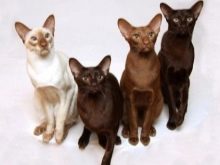
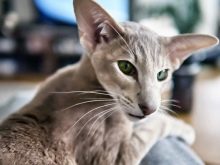
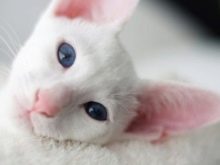
According to the colors of the orientals, there are also subspecies.
- Solid When the color runs evenly throughout the cat's body. That is, the skin on the nose and legs is also the same color as the coat.
- Shaded Animals have black hair on their backs, but due to the undercoat, the color on their sides goes into a lighter color and completely lightens on the stomach and tip of the tail.
- Smoke In another way it is called smoky. With a dark color, there is a light undercoat, which is visible only when the animal is moving. It’s hard to determine from the photo, so it’s better to watch such a cat live.
- Parti-color. This is a tortie color. As a rule, only cats have it, but cats are a rare exception. Spots of a different color are evenly distributed over the coat. Most often, colors with cream or red spots are found.
- Bi-Color. Cats are usually one-color, except for the paws, abdomen, muzzle and chest, which are white. Eyes can be green and blue.
- Tabby This is one of the common species, which in turn is also divided into subspecies. Cats of this kind are very popular. The color of the tabby is characterized by the imposition of a certain pattern on the uniform coat color.
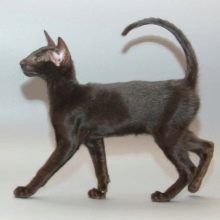
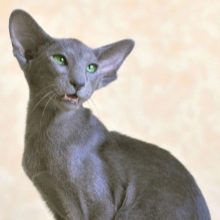

According to the drawings, the tabby is divided into the following types:
- brindle - the main strip is located on the back, from which lighter stripes go down on the sides;
- spotted - in another way it can also be called leopard because of contrasting spots on the wool;
- marble - the most rare color; kittens are born only from “marble” parents who have the gene for such a pattern in their blood, the strips go along the body and only further emphasize the refined silhouette of the animal, the kids are very much like chipmunks;
- ticked - outwardly resembles a one-color animal, with each hair hair dyed along its entire length; There are light and dark tones.
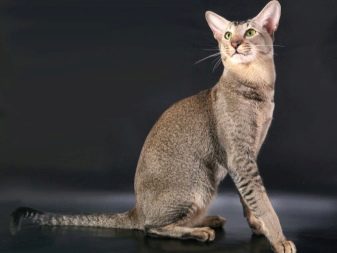
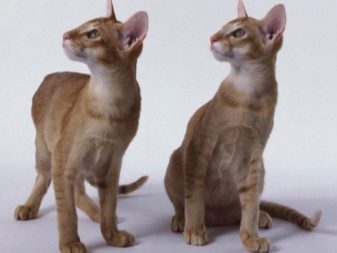
The main requirement for cats with a tabby pattern is the contrast between the main coat color and the tone of the pattern.
For cats of a single color, another requirement: there should be no spots and marks of a different color. Oriental breed cats have a special color.
In the photographs, such animals look very unusual due to the completely white color, without any hint of shades. The eyes in such cats can be green or blue, but eyes of different colors look especially exotic - one is blue, the second is green.

Conditions of detention
No special breed care is required. Cats themselves with pleasure watch their hair. But still, it’s best to help the animal, combing it out twice a week with a rubber mitt during moulting. You can replace it with a damp cloth to collect pieces of shedding wool. It is necessary to bathe an animal in rare cases. Usually before participating in the exhibition.
It is recommended that you clean your ears once a week. The procedure is carried out with cotton buds and a mild cleansing lotion or petroleum jelly. Eyes must be treated with a cotton pad moistened with water, which will allow them to cleanse of mucus. Brushing your teeth is also a necessary procedure. Not every animal, especially if it is not tamed since childhood, will allow someone to poke around in their teeth.
In this case, dry food or special goodies come to the rescue, which help to solve the problem with plaque and tartar.

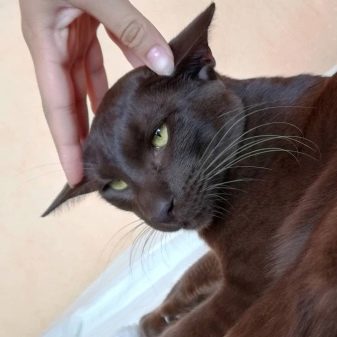
To care for your nails, you need a claw tip. Once a month, it is necessary to shorten the claws by 2 mm and no more so as not to injure the animal. If it fails at a time, you can carry out the procedure for several days. Orientals love to pick their home flowers, tasting leaves and stems. To prevent poisoning of the animal, plants such as Dieffenbachia and azaleas You must either remove it completely or put it in an unattainable place.
Cats are very curious and fearless, therefore it is important to keep an eye on the windows and balcony so that the animal does not fall from the floor. They quickly get used to the toilet. But if the kitten does not want to go to the tray, then you need to understand the reasons. Perhaps he does not like smells, especially if the tray is in the bathroom next to household chemicals. It may be that the animal’s toilet is in a prominent and noisy place.
If the kitten has settled down in the wrong place, you can scare it gently by clapping your hands softly and throwing a small soft toy. The main thing is that the animal does not understand that the threat comes from the owner.

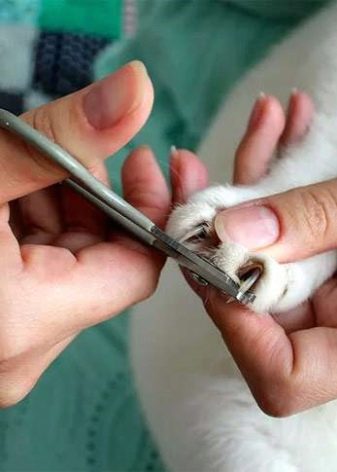
What to feed?
Orientals are lovers of delicious food. They are not embarrassed to grab a host of food from the table. But we must remember that the digestive system of such cats can not digest any product. Therefore, it is best to focus on industrial feed in nutrition. Oriental cats prefer wet food over dry. Owners are best fed mixed animals, alternating canned food and "drying". Mixing both types is strongly discouraged.
You can feed your pet with natural food: treat a piece of meat or fish, porridge in milk. But you should not get involved in this matter either, since Orientals may refuse industrial feed, and they are also prone to obesity.
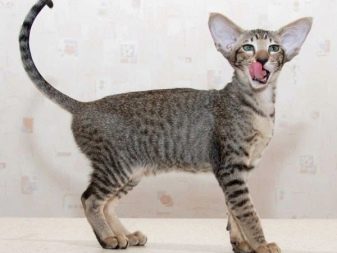
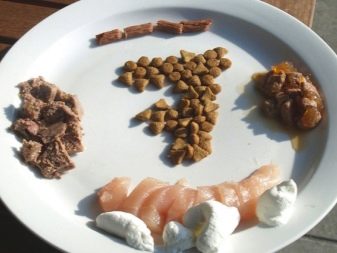
A cat should not be fed up for the future, so it is best to leave the necessary amount of food in a bowl. It is not necessary to feed the orientals on a schedule, as the animal will subconsciously prepare for a hunger strike and eat more food than expected. Must always be fresh water. You can feed the animal with vitamins and minerals. There are special complexes in vet shops.
To determine the "right" feed, you can navigate by the state of the coat. If it is soft and without dandruff, then the cat has proper nutrition.

Breeding
Breeding orientals requires experience. Finding a cat for mating is half the battle. Not the fact that the kittens will turn out exactly like a matched father. There are many nuances that experienced breeders know about.
- The oriental cat’s estrus is no different from other breeds. It is recommended that the breeding cat be knitted at least once a year and not more than once every six months. If the cat, in the presence of small kittens, asks for the cat again, it is better to follow the pet’s request and reduce it again.
- The knitting process must be approached very responsibly, taking into account the right time and the right partner. If show class kittens are needed, then both parents should be at the same level. However, there is no guarantee that the entire litter will correspond to the specified class.
- Only experienced breeders can determine the future fate of the litter - who is suitable for breeding or “leaves” in the so-called pet class (not suitable for breeding and participation in exhibitions).
- The pregnancy of the cat lasts from 58 to 70 days. Special care for the animals is not required, the only thing that will have to revise the diet, increasing the volume. You need to feed with special feeds for pregnant and lactating cats. The abdomen begins to grow at 4 weeks, and already at 6-7 weeks you can feel the stirring of kittens. When the eighth week arrives, it is necessary to prepare the place for the cat to give birth. It should be a secluded, peaceful place. The oriental childbirths are not much different from the others - she can calmly lie or run around the apartment, meowing. Childbirth can last from 2 to 6 hours.
- Kittens are usually given at the age of three months. When choosing a small oriental, attention should be paid to its appearance. The kitten should look healthy and nimble. Eyes and ears should be clean, no discharge, wool should shine in the sun.
- Upon purchase, the owner must give a metric or pedigree. If there are no documents, then most likely a kitten of mixed breed. If the animal is purchased for breeding, it is best to take it in the nursery. These are breeding cats with good pedigrees.
- Castration of the animal is carried out at the age of 8 to 12 months.
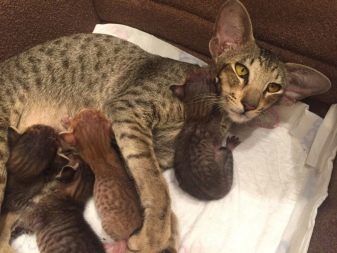
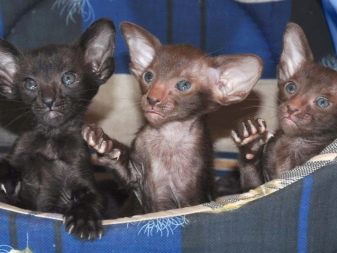
Owner reviews
For many, the cost of an animal seems unbearable. It depends on the class and color of the cat's coat. For example, "chocolate" kittens of a pet class are estimated from 25 thousand to 30 thousand rubles. If the same baby has shades of faun or cinnamon, then its cost doubles: from 45 thousand to 60 thousand rubles. The most expensive price tag for animals with pedigrees intended for breeding. The price per oriental kitten can reach 100 thousand rubles.
On the Internet you can find a variety of reviews about orientations. Someone likes a cat, people, despite the problems brought by animals, continue to adore a pet. And someone complains that the orientals are very talkative and intrusive.
Be that as it may, the acquisition of any animal is a responsibility for the lives of others for several years.
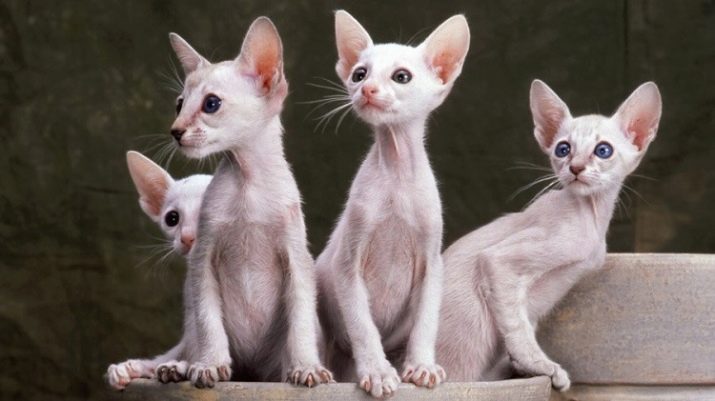
Oriental owners can be divided into two camps. In one, people are moved by pranks and pranks - tattered wallpapers, night runs on walls and curtains, a tour of the dining table and eating “sweets”, exploring shelves on cabinets - all this is just amusing. Therefore, we can say that these cats are intended for people of cheerful disposition who are easily related to everyday problems. For other owners, orientals deliver only torment in the form of night shouts, a touchy character, theft from a garbage can and torn rolls of toilet paper. In a word, the house is dirty and messy. Behind an unusual appearance, people bought an animal, which, in fact, is not simple in nature, as many seem to.
Owners are advised not to pamper the animal much, as it begins to become like a child for whom there are no barriers and nothing is possible. Cats are already demanding of themselves, and in this case they become very annoying until they achieve their goal. Do not forget that any cat walks by itself, especially such an unusual one. In this breed still makes itself felt independent character of the Siamese ancestor.
In the next video you will find more information about oriental cats and cats.
